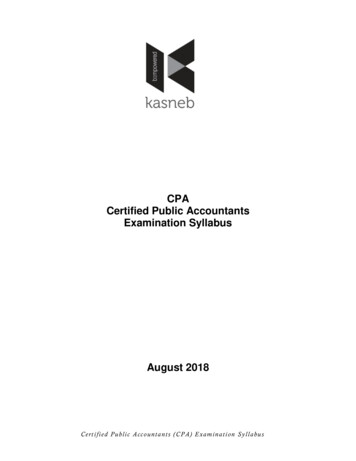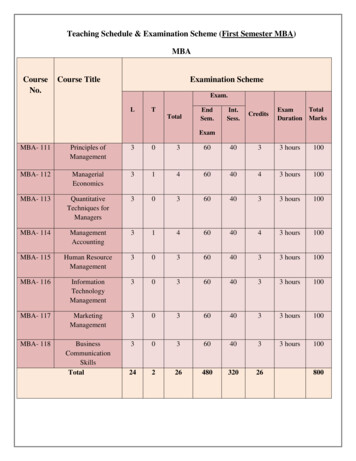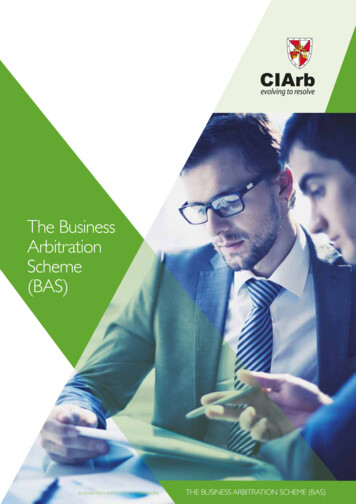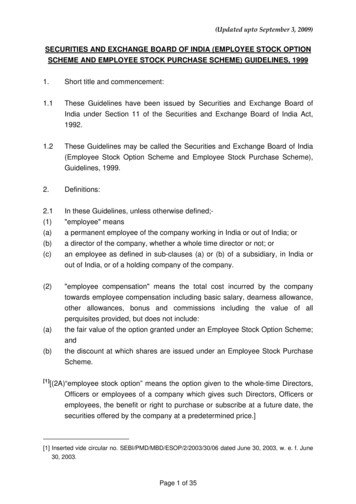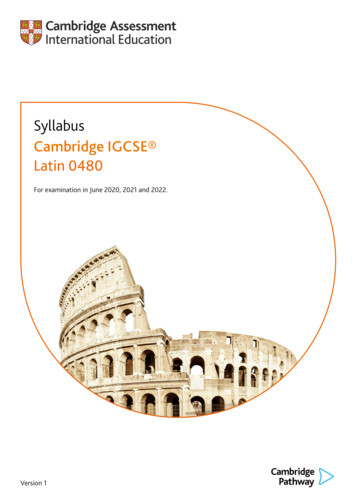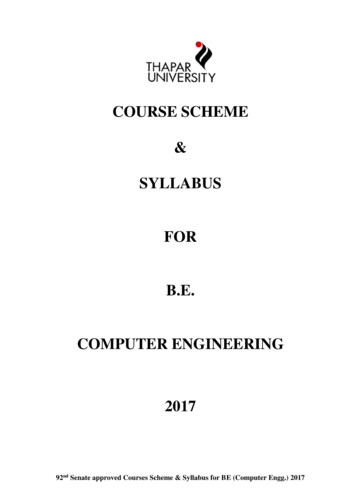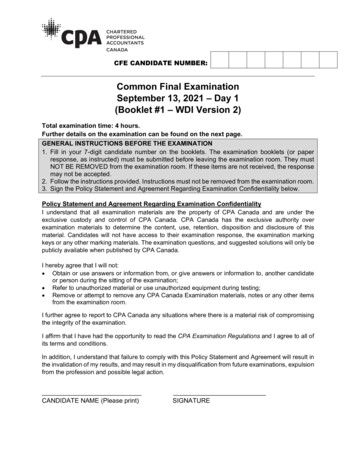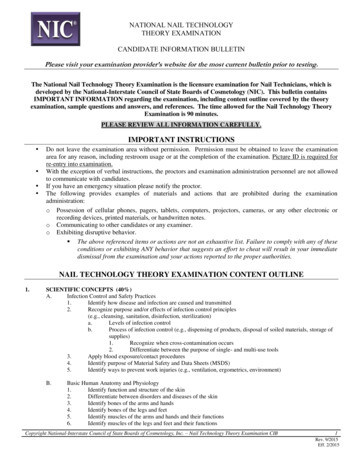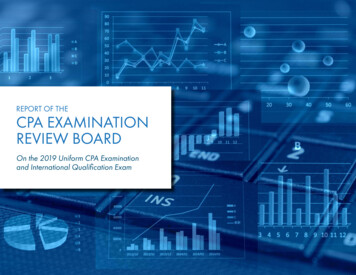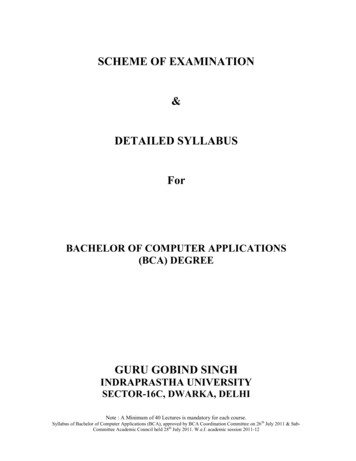
Transcription
SCHEME OF EXAMINATION&DETAILED SYLLABUSForBACHELOR OF COMPUTER APPLICATIONS(BCA) DEGREEGURU GOBIND SINGHINDRAPRASTHA UNIVERSITYSECTOR-16C, DWARKA, DELHINote : A Minimum of 40 Lectures is mandatory for each course.Syllabus of Bachelor of Computer Applications (BCA), approved by BCA Coordination Committee on 26 th July 2011 & SubCommittee Academic Council held 28 th July 2011. W.e.f. academic session 2011-12
Bachelor of Computer ApplicationsFIRST SEMESTER EXAMINATIONCode No.PaperLT/PCreditsMarksInternalMarksExternalBCA 101 Mathematics – I3142575BCA 103 TechnicalCommunicationBCA 105 Introduction toProgrammingLanguage using CBCA 107 Introduction toComputers & ITBCA 109 10060------171627305495THEROY PAPERSPRACTICALSBCA 151 Practical – I C Prog.LabBCA 153 Practical – II IT LabBCACommunication Skills155*Total*NUESTOTAL MARKS : 800Note : A Minimum of 40 Lectures is mandatory for each course.Syllabus of Bachelor of Computer Applications (BCA), approved by BCA Coordination Committee on 26 th July 2011 & SubCommittee Academic Council held 28 th July 2011. W.e.f. academic session 2011-12
Bachelor of Computer ApplicationsSECOND SEMESTER EXAMINATIONCode No.PaperLT/PCreditsMarksInternalMarksExternalBCA 102 Mathematics – II3142575BCA 104 Principles ofManagementBCA 106 Digital Electronics30325753142575BCA 108 Data Structure Using C 3142575BCA 110 Database 71627305495THEROY PAPERSPRACTICALSBCA 152 Practical – III DS LabBCA 154 Practical – IV DBMSLabBCACyber Ethics156*Total*NUESTOTAL MARKS: 800Note : A Minimum of 40 Lectures is mandatory for each course.Syllabus of Bachelor of Computer Applications (BCA), approved by BCA Coordination Committee on 26 th July 2011 & SubCommittee Academic Council held 28 th July 2011. W.e.f. academic session 2011-12
Bachelor of Computer ApplicationsTHIRD SEMESTER EXAMINATIONCode No.PaperLT/PCreditsMarksInternalMarksExternalBCA 201 Mathematics – III3142575BCA 203 Computer Architecture3142575BCA 205 Front End Design ToolVB.NetBCA 207 Principles ofAccountingBCA 209 Object OrientedProgramming usingC 1627305495THEROY PAPERSPRACTICALSBCA 251BCA 253BCA255*Practical – V .NET LabPractical – VI C LabSoftware DevelopmentSkillsTotal*NUESTOTAL MARKS: 800Note : A Minimum of 40 Lectures is mandatory for each course.Syllabus of Bachelor of Computer Applications (BCA), approved by BCA Coordination Committee on 26 th July 2011 & SubCommittee Academic Council held 28 th July 2011. W.e.f. academic session 2011-12
Bachelor of Computer ApplicationsFOURTH SEMESTER EXAMINATIONCode No.PaperLT/PCreditsMarksInternalMarksExternalBCA 202 Mathematics – IV3142575BCA 204 Web Technologies3142575BCA 206 Java Programming3142575BCA 208 Software Engineering3142575BCA 210 Computer 495THEROY PAPERSPRACTICALSBCA 252 Practical – VII JavaLabBCA 254 Practical – VIII WebTech LabBCAPersonality256*Development SkillsTotal*NUESTOTAL MARKS: 800Summer Training will be held for 4 weeks after the end of fourth semester.Viva-Voce will be conducted in fifth semester.Note : A Minimum of 40 Lectures is mandatory for each course.Syllabus of Bachelor of Computer Applications (BCA), approved by BCA Coordination Committee on 26 th July 2011 & SubCommittee Academic Council held 28 th July 2011. W.e.f. academic session 2011-12
Bachelor of Computer ApplicationsFIFTH SEMESTER EXAMINATIONCode No.PaperLT/PCreditsMarksInternalMarksExternalBCA 301 Operating System3142575BCA 303 Computer Graphics3142575BCA 305 E- Commerce3142575BCA 307 Software Testing3142575BCA 309 Microprocessor3142575BCA 311 Advance ComputerNetworksBCA 313 Web BasedProgrammingBCA 315 Business Economics314257531425753142575Practical – IX CG LabSummer Project/TrainingMinor 20THEROY PAPERS***ELECTIVES (Select any One)PRACTICALSBCA 351BCA355*BCA 357*Evaluation will be based on Summer Training held after fourth semester and will beconducted by the college committee only.*** Any Elective Subject will be offered if minimum 1/3 rd of the total strength ofstudents in the class will opt for it.**NUESTOTAL MARKS: 700Note : A Minimum of 40 Lectures is mandatory for each course.Syllabus of Bachelor of Computer Applications (BCA), approved by BCA Coordination Committee on 26 th July 2011 & SubCommittee Academic Council held 28 th July 2011. W.e.f. academic session 2011-12
Bachelor of Computer ApplicationsSIXTH SEMESTER EXAMINATIONCode No.PaperLT/PCreditsMarksInternalMarksExternalBCA 302 Data Ware Housing &Data MiningBCA 304 Mobile Computing31425753142575BCA 306 Linux Environment3142575BCA 308 Multimedia & ItsApplicationsBCA 310 Bio Informatics31425753142575BCA 312 Artificial Intelligence3142575BCA 314 Network Security3142575BCA 316 Network 420THEROY PAPERS***ELECTIVES (Select any One)PRACTICALSBCA 352 Practical – X LinuxLabBCA 356 Major ProjectBCASeminar358**TotalNote:1.The total number of the credits of the BCA programme 160.2.Each student shall be required to appear for examinations in all courses. However, forthe award of the degree a student shall be required to earn the minimum of 150 credits.Total Marks : 700*** Any Elective Subject will be offered if minimum 1/3 rd of the total strength of studentsin the class will opt for it.Note : A Minimum of 40 Lectures is mandatory for each course.Syllabus of Bachelor of Computer Applications (BCA), approved by BCA Coordination Committee on 26 th July 2011 & SubCommittee Academic Council held 28 th July 2011. W.e.f. academic session 2011-12
Paper Code: BCA 101Paper ID: 20101LTCPaper: Mathematics – I314Aim: To understand the basic concepts of mathematics.Objectives To get the knowledge about the matrices, determinants and limits. To study the basics of differential and integral calculusINSTRUCTIONS TO PAPER SETTERS:Maximum Marks : 751.Question No. 1 should be compulsory and cover the entire syllabus. This questionshould have objective or short answer type questions. It should be of 25 marks.2.Apart from Question No. 1, rest of the paper shall consist of four units as per thesyllabus. Every unit should have two questions. However, student may be asked toattempt only 1 question from each unit. Each question should be 12.5 marksUNIT - IDETERMINANTS: Definition, Minors, Cofactors, Properties of Determinants, MATRICES:Definition, Types of Matrices, Addition, Subtraction, Scalar Multiplication and Multiplicationof Matrices, Adjoint, Inverse, Cramers Rule, Rank of Matrix Dependence of Vectors, Eigen Vectors of a Matrix, Caley-Hamilton Theorem (without proof)[No. of Hrs: 12]UNIT – IILIMITS & CONTINUITY: Limit at a Point, Properties of Limit, Computation of Limits ofVarious Types of Functions, Continuity at a Point, Continuity Over an Interval, IntermediateValue Theorem, Type of Discontinuities.[No. of Hrs: 10]UNIT-IIIDIFFERENTIATION: Derivative, Derivatives of Sum, Differences, Product & quotients,Chain Rule, Derivatives of Composite Functions, Logarithmic Differentiation, Rolle’sTheorem, Mean Value Theorem, Expansion of Functions (Maclaurin’s & Taylor’s),Indeterminate Forms, L’ Hospitals Rule, Maxima & Minima, Asymptote, SuccessiveDifferentiation & Liebnitz Theorem.[No. of Hrs: 12]UNIT – IVINTEGRATION: Integral as Limit of Sum, Riemann Sum, Fundamental Theorem of Calculus,Indefinite Integrals, Methods of Integration Substitution, By Parts, Partial Fractions, Integrationof Algebraic and transcedental Functions, Reduction Formulae for Trigonometric Functions,Gamma and Beta Functions.[No. of Hrs: 10]TEXT BOOKS:[T1] Kresyig E., “Advanced Engineering Mathematics”, 5th Edition, John Wiley & Sons,1999.[T2] Babu Ram, “Engineering Mathematics”, Pearson Education.[T3] Apostol Tom M, Calculus, Vol I and II John Wiley (2003).REFERENCE BOOKS:[R1] B.S. Grewal, “Elementary Engineering Mathematics”, 34th Ed., 1998.[R2] H.K. Dass, “Advanced Engineering Mathematics”, S. Chand & Company, 9th RevisedEdition, 2001.[R3] Shanti Narayan, “Differential Calculas”, S.Chand & Company, 1998Note : A Minimum of 40 Lectures is mandatory for each course.Syllabus of Bachelor of Computer Applications (BCA), approved by BCA Coordination Committee on 26 th July 2011 & SubCommittee Academic Council held 28 th July 2011. W.e.f. academic session 2011-12
Paper Code: BCA 103LTCPaper Id: 20103303Paper: Technical CommunicationPre-requisites: NoneAim : To Understand the correct use of English Language and improve the CommunicationSkills of the students.Objectives To have basic understanding of the correct use of English Language. To improve oral as well as written communication skills.INSTRUCTIONS TO PAPER SETTERS:Maximum Marks: 751. Question No. 1 should be compulsory and cover the entire syllabus. This question shouldhave objective or short answer type questions. It should be of 25 marks.2. Apart from Question No. 1, rest of the paper shall consist of four units as per the syllabus.Every unit should have two questions. However, student may be asked to attempt only 1question from each unit. Each question should be 12.5 marks.UNIT-IConcepts and Fundamentals: Introduction to Technical Communication, meaning ofcommunication, Importance of communication, Communication scope, types, Process ofcommunication, Communication models and theories, Essentials of good communication - Theseven Cs of communication, Factors responsible for growing importance of communication,Channels of communication, Verbal and Non-Verbal communication, Formal and Informalcommunication, Barriers of, and aids to communication.[T1, T2, T3, T4][No. of Hrs: 11]UNIT-IIWritten Communication: Objectives of written communication, Media of writtencommunication, Merits and demerits of written communication, Planning and preparing ofeffective business messages. Persuasive writing.Overview of Technical Research and Report Writing : Definition and Nature of TechnicalWriting, Properties/features and process of Technical Writing, Basic Principles of TechnicalWriting, Styles in Technical Writing, The Role of Technical Writing, The Wholistic Guide ofTechnical Writing , End-products of Technical Writing. Writing Proposals.Writing Letters: Business letters, Office memorandum, Good news and bad news letters,Persuasive letters, Sales letters, Letter styles/ layout.Report Writing: Meaning & Definition, Types of report (Business report & Academic report),Format of report, Drafting the report, Layout of the report, Essential requirement of good reportwriting.Job Application: Types of application, Form & Content of an application, drafting theapplication, Preparation of resume. [T1,T2,T3,][No. of Hrs: 11]UNIT-IIIOral Communication: Principles of effective oral communication, Media of oralcommunication, Advantages of oral communication, Disadvantages of oral communication,Styles of oral communication.Note : A Minimum of 40 Lectures is mandatory for each course.Syllabus of Bachelor of Computer Applications (BCA), approved by BCA Coordination Committee on 26 th July 2011 & SubCommittee Academic Council held 28 th July 2011. W.e.f. academic session 2011-12
Interviews: Meaning & Purpose, Art of interviewing, Types of interview, Interview styles,Essential Features, Structure, Guidelines for Interviewer, Guidelines for interviewee.Meetings: Definition, Kind of meetings, Advantages and disadvantages of meetings/committees, Planning and organization of meetings.Project Presentations: Advantages & Disadvantages, Executive Summary, Charts, Distributionof time (presentation, questions & answers, summing up), Visual presentation, Guidelines forusing visual aids, Electronic media (power-point presentation).Listening Skills: Good listening for improved communications, Art of listening, Meaning,nature, process, types and importance of listening, Principles of good listening, Barriers inlisteningNegotiation Skills : Definition of negotiation, Factors that can influence negotiation, what skillsdo we need to negotiate, Negotiation process (preparation, proposals, discussions, bargaining,agreement, implementation).Strategies to, improve oral, presentation, speaking and listening skills. [T1,T2, T3,T4][No. of Hrs: 11]UNIT-IVSoft Skills: Non Verbal communication- kinesics & Proxemics, parlanguage, interpersonalskills, Corporate communication skills - Business Etiquettes [T1,T2,T4]Language Skills: Improving command in English, improving vocabulary, choice of words,Common problems with verbs, adjectives, adverbs, pronouns, tenses, conjunctions,punctuations, prefix, suffix, idiomatic use of prepositions. Sentences and paragraphconstruction, improve spellings, introduction to Business English. [T3, R1, R3][No. of Hrs: 11]TEXTBOOKS:[T1] Kavita Tyagi and Padma Misra , “Advanced Technical Communication”, PHI, 2011[T2] P.D.Chaturvedi and Mukesh Chaturvedi, “Business Communication – Concepts, Casesand Applications”, Pearson, second edition.[T3] Rayudu, “C.S- Communication”, Himalaya Publishing House, 1994.[T4] Asha Kaul , “Business Communication”, PHI, second edition.REFERENCES:[R1] Raymond Murphy, “Essential English Grammar- A self study reference and practicebook for elementary students of English” , Cambridge University Press, second edition.[R2] Manalo, E. & Fermin, V. (2007). Technical and Report Writing. ECC Graphics. QuezonCity.[R3] Kavita Tyagi and Padma Misra , “Basic Technical Communication”, PHI, 2011.[R4] Herta A Murphy, Herbert W Hildebrandt and Jane P Thomas, “Effective BusinessCommunication”, McGraw Hill, seventh edition.Note : A Minimum of 40 Lectures is mandatory for each course.Syllabus of Bachelor of Computer Applications (BCA), approved by BCA Coordination Committee on 26 th July 2011 & SubCommittee Academic Council held 28 th July 2011. W.e.f. academic session 2011-12
Paper Code: BCA 105LTCPaper Id: 20105314Paper: Introduction to Programming Language using CPre-requisites: NoneAim : To Understand the Programming Fundamentals and the basics of the ‘C’ ProgrammingLanguage.Objectives: To be able to build own logic for a given problem and finally develop one’s ownprograms To understand the syntax and the semantics of C programming language.INSTRUCTIONS TO PAPER SETTERS:Maximum Marks: 751. Question No. 1 should be compulsory and cover the entire syllabus. This question shouldhave objective or short answer type questions. It should be of 25 marks.2. Apart from Question No. 1, rest of the paper shall consist of four units as per the syllabus.Every unit should have two questions. However, student may be asked to attempt only 1question from each unit. Each question should be 12.5 marks.UNIT IC basics: C character set, Identifiers and keywords, Data types, constants, variables and arrays,declarations, expressions statements, symbolic constants, compound statements, arithmeticoperators, unary operators, relational and logical operators, assignment operators, conditionaloperators, bit operators.C constructs: If statement, if .else statement, if .else if .else statement, while statement,do .while statement, for statement, switch statement, nested control statement, break operator,continue operator, comma operator, goto statement. .[T1,T2,T3][No. of Hrs: 11]UNIT – IIC Functions: Functions: declaration, definition & scope, recursion, call by value, call byreference.Storage Classes: automatic, external (global), static & registers.Arrays: Arrays, pointers, array & pointer relationship, pointer arithmetic, dynamic memoryallocation, pointer to arrays, array of pointers, pointers to functions, array of pointers tofunctions, Preprocessor directives: #include, #define, macro’s with arguments, the operators #and ##, conditional compilations. [T1,T2,T3][No. of Hrs: 11]UNIT – IIIStructures: Structures, unions, passing structure to functions, bit fields, file handling [text(ASCII), binary] [T1,T2,T3][No. of Hrs: 11]UNIT – IVString manipulation functions and other standard library functions from stdio.h, stdlib.h,conio.h, ctype.h, math.h, string.h, process.h.Note : A Minimum of 40 Lectures is mandatory for each course.Syllabus of Bachelor of Computer Applications (BCA), approved by BCA Coordination Committee on 26 th July 2011 & SubCommittee Academic Council held 28 th July 2011. W.e.f. academic session 2011-12
Usage of command line arguments. [T1, T2, T3][No. of Hrs: 11]TEXTBOOKS:[T1]Ashok N. Kamthane, “Computer Basics and C Programming”, Pearson Education.[T2]E. BalaGuruswamy, “Programming in ANSI C”, 2008.[T3]V Rajaraman, “Computer Basics and C Programming”, PHI.REFERENCES:[R1]Herbert Schildt, “C The Complete Reference” Fourth Edition, 2000.[R2]Yashwant Kanetkar, “Let us C” eighth edition, 2002.[R3]Kernighan and d. Ritchie, “The ANSI C Programming Language”, 2000.[R4]Stephenn Prata, “C Primer Plus” Fourth Edition, 2001.[R5]Schaum’s Outline Series, “Programming with C”, 2nd Edition, 1996.Note : A Minimum of 40 Lectures is mandatory for each course.Syllabus of Bachelor of Computer Applications (BCA), approved by BCA Coordination Committee on 26 th July 2011 & SubCommittee Academic Council held 28 th July 2011. W.e.f. academic session 2011-12
Paper Code:BCA 107LTCPaper ID: 20107314Paper: Introduction to Computers and ITPre-requisites:NoneAim:To provide the students Basic knowledge of computers and information technology.ObjectivesThis is an elementary course in computers and information technology. Upon completion of thiscourse the student should be able to: Discuss the evolution of computers in different generations. Classify computers in different categories based on their capabilities. Describe the major components of computers and information technology applications:Hardware, software, data, processes, computer networks and people. Demonstrate an understanding of the importance of algorithms in the development of ITapplications.INSTRUCTIONS TO PAPER SETTERS:Maximum Marks: 751. The paper setters are required to restrict upto the overview of the concepts.2. Question No.1 should be compulsory and cover the entire syllabus. This question should haveobjective or short answer type questions. It should be of 25 marks.3. Apart from Question No. 1, rest of the paper shall consist of four units as per the syllabus.Every unit should have two questions. However, student may be asked to attempt only 1question from each unit. Each question should be 12.5 marks.UNIT – IIntroduction to Computers:The evolution of computers: Computer Generation from First Generation to Fifth Generation.Classifications of Computers: Micro, Mini, Mainframe and super computers, DistributedComputer System, Parallel Computers.Computer Hardware: Major Components of a digital computer, Block Diagram of a computerInput-output devices, Description of Computer Input Units, Output Units. CPU.Computer Memory: Memory Cell, Memory Organization, Read Only Memory, Serial AccessMemory, Physical Devices Used to construct Memories, Magnetic Hard disk, floppy DiskDrives, Compact Disk Read Only Memory, Magnetic Tape Drives. [T1][R1] [No. of Hrs: 12]UNIT – IIInteraction With Computers:Computer Software: System software, assemblers, compilers, interpreters, linkers ElementaryOperating System concepts, different types of operating systems, Application Software:Introduction to MS Office (MS-Word, MS Powerpoint, MS-Excel) Computer Programming andLanguages: Algorithms, flow chart, decision tables, pseudo code, Low level languages andintroduction to high level languages. [T1][T2][R3][No. of Hrs: 12]UNIT – IIIComputer Number System: Decimal, Binary, Octal, Hexa-decimal.Conversion: Decimal toall other number systems, Binary to octal and hexa decimal, Addition of binary numbers, Binarysubtraction, Use of complements to represent negative numbers, Conversion of a binary fractionto a decimal fraction and decimal to binary fraction, Binary Coded Decimal(BCD), ASCIICodes, EBCDIC codes, Gray codes, Unicodes.[T1][R1][No. of Hrs: 10]Note : A Minimum of 40 Lectures is mandatory for each course.Syllabus of Bachelor of Computer Applications (BCA), approved by BCA Coordination Committee on 26 th July 2011 & SubCommittee Academic Council held 28 th July 2011. W.e.f. academic session 2011-12
UNIT – IVComputer Network & InternetBasic elements of a communication system, Data transmission modes, Data Transmissionspeed, Data transmission media, Digital and Analog Transmission, Network topologies,Network Types (LAN, WAN and MAN), Client and Servers , Intranet, Extranet.Internet: Terminologies related to Internet: Protocol, Domain name, IP address, URL, WorldWide Web.Overview of various services on Internet: E-mail, FTP, Telnet, Chat , Instant Messaging.[T1][T2][R1][R2][No. of Hrs: 10]TEXT BOOKS[T1] P. K. Sinha & Priti Sinha , “Computer Fundamentals”, BPB Publications, 1992.[T2] Anita Goel “Computer Fundamentals”, Pearson.REFERENCE BOOKS[R1] B.Ram Computer fundamentals Architecture and Organization,New Age Intl.[R2] Alex Leon & Mathews Leon, “Introduction to Computers”, Vikas Publishing .[R3] Norton Peter, “Introduction to computers”, 4th Ed., TMH, 2001.[R4] Vikas Gupta, “Comdex Computer Kit”, Wiley Dreamtech, Delhi, 2004.Note : A Minimum of 40 Lectures is mandatory for each course.Syllabus of Bachelor of Computer Applications (BCA), approved by BCA Coordination Committee on 26 th July 2011 & SubCommittee Academic Council held 28 th July 2011. W.e.f. academic session 2011-12
Paper Code : BCA 109LTCPaper ID: 20109314Paper : PhysicsAim: To know the fundamentals of PhysicsObjectives To get the knowledge about the basic laws of nature such as motion, work, power andenergy To study the electrostatics, semiconductors and devices.INSTRUCTIONS TO PAPER SETTERS:MAXIMUM MARKS: 751. Question No. 1 should be compulsory and over the entire syllabus. It should be of 25marks and it may contain objective or short type question.2. Rest of the paper shall contain two questions from each unit. However students willattempt only one question from each unit. Each question should be 12.5 marks.UNIT – ILaw of Motion: Force and Inertia, Law of inertia or Newton’s first law of motion, Newton’sSecond law of motion, Newton’s third law of motion and it’s applications, Basic forces innature, Weight of body in lift, Equilibrium of concurrent forces, Lemi’s TheoremFriction: Cause of friction, Types of friction, Laws of friction, Angle of friction and repose,Centripetal and centrifugal force, velocity of vehicle on curved leveled and banked road.[T1] [T2][No. of Hrs: 11]UNIT – IIWork, Energy & Power: Work, Conservative force, Power, Kinetic Energy, Work energytheorem, Potential Energy, Conservation of gravitational P.E. into K.E., P.E. of spring.Collisions: Types of collision, elastic collision in 1D & 2D, Inelastic collision in 1D, Perfectlyinelastic collision in 1D.[T1] [T2][No. of Hrs: 11]UNIT – IIIElectricity & electromagnetism: Electric charge, Electron theory of electrification, Frictionalelectricity, Properties of electric charge, Coulomb’s Law, Superposition Principle, Electric fieldintensity, Electric Lines of forces.Electrostatics: Line integral of electric field, Electrostatic potential, State & Proof of Gauss’stheorem.Capacitance: Principal of Capacitor, Parallel and spherical capacitors, Grouping of capacitorsand their capacitance, Effect of dielectric in capacitors.Current Electricity: Current, Ohm’s Law, Resistance, Grouping of resistance, Krichoff’s rule,Wheatstone bridge, Slide Wire Bridge. [T3] [T4][No. of Hrs: 11]UNIT – IV:Structure of Atom: Thomson’s atomic model, Rutherford’s alpha scattering experiment andatomic model, Postulates of Bohr’s Model.Semiconductors: Energy bands in solids, Difference between metals, insulators and semiconductors, Current carriers in semiconductors, Intrinsic semiconductor, Doping, Extrinsicsemiconductors, Formation of p-n junction, Biasing of p-n junction, Light emitting diode.Transistors: Action of n-p-n & p-n-p transistors, Advantages of transistors, IntegratedCircuit.[T3] [T4][No. of Hrs: 11]TEXTBOOKS:[T1]: S.K. Gupta, “Modern ABC of Physics”, Vol1, Modern Publishers.Note : A Minimum of 40 Lectures is mandatory for each course.Syllabus of Bachelor of Computer Applications (BCA), approved by BCA Coordination Committee on 26 th July 2011 & SubCommittee Academic Council held 28 th July 2011. W.e.f. academic session 2011-12
[T2]: Pradeep, “Fundamental Physics”, Class XI, Pradeep Publications.[T3]: S.K. Gupta, “Modern ABC of Physics”, Vol2, Modern Publishers.[T4]: Pradeep, “Fundamental Physics”, Class XII, Pradeep Publications.Note : A Minimum of 40 Lectures is mandatory for each course.Syllabus of Bachelor of Computer Applications (BCA), approved by BCA Coordination Committee on 26 th July 2011 & SubCommittee Academic Council held 28 th July 2011. W.e.f. academic session 2011-12
Paper Code: BCA 102Paper ID: 20102Paper: Mathematics – IIL3T1C4Aim: To understand the basics concepts of Discrete Mathematical Structures.Objectives To get the Knowledge about sets, relations and functions. To study the basics of lattices and graphs. To get familiar with propositional logic.INSTRUCTIONS TO PAPER SETTERS:Maximum Marks : 751.Question No. 1 should be compulsory and cover the entire syllabus. This questionshould have objective or short answer type questions. It should be of 25 marks.2.Apart from Question No. 1, rest of the paper shall consist of four units as per thesyllabus. Every unit should have two questions. However, student may be asked toattempt only 1 question from each unit. Each question should be 12.5 marksUNIT ISETS: Sets, Subsets, Equal Sets Universal Sets, Finite and Infinite Sets, Operation on Sets,Union, Intersection and Complements of Sets, Cartesian Product, Cardinality of Set, SimpleApplications.RELATIONS AND FUNCTIONS: Properties of Relations, Equivalence Relation, PartialOrder Relation Function: Domain and Range, Onto, Into and One to One Functions, Compositeand Inverse Functions, Hashing functions, Recursive function. [T1][T2] [No. of Hrs: 11]UNIT – IIPARTIAL ORDER RELATIONS AND LATTICES: Partial Order Sets, Representation ofPOSETS using Hasse diagram, Chains, Maximal and Minimal Point, Glb, lub, Lattices &Algebric Systems, Principle of Duality, Basic Properties, Sublattices, Distributed &Complemented Lattices. [T1][T2][No. of Hrs: 10]UNIT-IIIGraphs: types and operations(bipartite graph. Subgraph, distance of a graph, cut-edges & cutvertices, isomorphic and homomorphic graphs), degree of graphs, adjacent and incidencematrices, path circuit(Floyd’s and Warshall algorithms), hamiltonian graph, graph colouring.[T1][T2][No. of Hrs: 12]UNIT – IVPropositional Logic: Proposition, First order logic, Basic logical operation, truth tables,tautologies, contradictions, Algebra of Proposition, logical implications, logical equivalence,predicates, Universal and existential quantifiers. [T1[T2][No. of Hrs: 11]TEXT BOOKS:[T1]Rosen, K.H., Discrete Mathematics and its Applications, McGraw Hill, (2006) 6th ed.[T2]Kolman, Busby and Ross, “Discrete Mathematical Structure”, PHI, 1996.[T3]Babu Ram, “Discrete Mathematics”, Pearson EducationREFERENCE BOOKS:[T1]S.K. Sarkar, “Discrete Maths”; S. Chand & Co., 2000.Note : A Minimum of 40 Lectures is mandatory for each course.Syllabus of Bachelor of Computer Applications (BCA), approved by BCA Coordination Committee on 26 th July 2011 & SubCommittee Academic Council held 28 th July 2011. W.e.f. academic session 2011-12
[T2]Tremblay, J.P. and Manohar, R., Discrete Mathematical Structures with Applications toComputer Science, Tata McGraw Hill, (2007).Note : A Minimum of 40 Lectures is mandatory for each course.Syllabus of Bachelor of Computer Applications (BCA), approved by BCA Coordination Committee on 26 th July 2011 & SubCommittee Academic Council held 28 th July 2011. W.e.f. academic session 2011-12
Paper Code: BCA – 104L TCPaper ID: 20104330Paper: Principles of ManagementPre-requisites: NoneAim: To understand the function of management and their application in the corporate world.Objectives To get the knowledge about the important management concepts & their application, To have an insight of various functional departments in an organization. To make students well versed with programming in java.INSTRUCTIONS TO PAPER SETTERS:Maximum Marks: 751. Question No. 1 should be compulsory and cover the entire syllabus. This question shouldhave objective or short answer type questions. It should be of 25 marks.2. Apart from Question No. 1, rest of the paper shall consist of four units as per the syllabus.Every unit should have two questions. However, student may be asked to attempt only 1question from each unit. Each question should be 12.5 marks.UNIT – IManagement: Meaning & concept, Management principles (Fayol & Taylor), Managementprocess (in brief), Managerial levels, Roles & skills of a manager, Management Theories(Classical, Neo classical, Behavioral, Systems & Contingency) [Elementary][T1,R1][No. of hrs.-12]UNIT – II :Planning: Meaning, Purpose & process, Decision making: Concept & process,Organizing: Process, Departmentation, Authority & Responsibility relationships,Decentralization. Staffing: Nature & Importance, [T1,R1][No. of hrs.-10]UNIT-IIIStaffing: Concept, nature & importance of staffing.Directing: Motivation: concept & theories (Maslow’s, Herzberg Two factor, McGregor’stheory X & Y) , Leadership: Concepts & styles.Controlling: Nature, Importance, significance & Process of control.[T1,R1][No. of hrs.-12]UNIT – IVManaging People - Meaning, Need of understanding human behavior in organization, Modelsof OB, Major concepts in OB (elementary)- Personality, Learning, Perception & AttitudeBuilding. [T1,R2, R3][No. of hrs.-10]TEXT BOOKS[T1] Dr. C.B Gupta “Management concepts & practices” S.Chand & Sons, 2009.REFERENCE BOOKS[R1] Stoner,Freeman & Gilbert, “Management” 6th Edition, Pearson International.Note : A Minimum of 40 Lectures is mandatory for
BCA 302 Data Ware Housing & Data Mining 3 1 4 25 75 BCA 304 Mobile Computing 3 1 4 25 75 BCA 306 Linux Environment 3 1 4 25 75 . To understand the basic concepts of mathematics. . "Advanced Engineering Mathematics", 5th Edition, John Wiley & Sons,1999. [T2] Babu Ram, "Engineering Mathematics", Pearson Education. [T3] Apostol Tom M .


